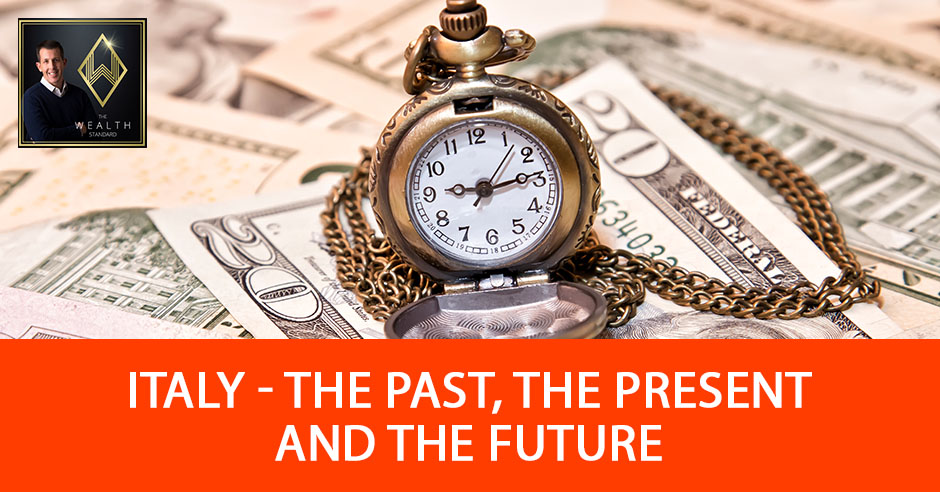Podcast: Play in new window | Download

Humans are designed to grow, to expand, and to solve new problems. It may be at various levels and capacities based on our uniqueness, but we all have that within each of us. With that in mind, how do you get a 10% raise for life? There are actually more opportunities to work from home or work in a place you want to live in because of how society is progressing. Everything is within your reach because of the internet. Knowing that all these options exist creates focus and ultimately a path to build your value statement. In this episode, Patrick tackles how to make more money or make the same amount of money with less time and do it every year.
—
Watch the episode here:
Listen to the podcast here:
Italy – The Past, The Present And The Future
Financial Friday
I am in a different location than Salt Lake City, Utah, my home office. I’m actually in Florence, Italy. My wife has had a dream of coming here for so many years and there’s actually a conference that I’m attending so we’re excited to extend a little bit and visit a few cities. We were in Milan, then went to Venice for a few days, then came here to the conference in Florence. Then we’re headed to Rome for a few days. We’re hitting all of the hot spots. I thought what would be appropriate for this episode is to talk about Italy, the past, the present and the future, and what that has to do with you specifically in regards to the idea of compound interest. Get ready for another episode.
—
Let’s first talk about the past. I’ve mentioned this in episodes of the past, but Italy is actually credited as being the ground zero for banking. It’s really the more robust organizations. They had massive influence that started here in Italy and you can still see signs of that. One of the most prominent families, probably one of the more well-known ones was the Medici family. You could see their coat of arms everywhere and it’s popular here. I learned a few different things I thought that would be interesting for you. First off, they’re the first prominent banking family that had tremendous influence during the Renaissance era. Eventually part of this line became Popes and lots of influence. From a banking perspective, here’s something that’s pretty fascinating. They’re credited with the creation of double accounting using two variables: credits and debits. The banking family also funded the creation of the opera and they also funded the creation of the piano. These are things that we look at every day and realize that they’re just a part of our culture, but they weren’t necessarily here several thousand years ago. It’s interesting to see that history behind it and that it was funded by credit, by somebody taking a loan, using that loan to make something. In this case, it was opera and the piano.
However, a lot of the early banking families like the Rothschilds, obviously the Medici family is also part of it, they lent a lot of money to the Catholic Church. In addition to these ventures, the opera and the piano, the Medici family also funded the construction of St. Peter’s Basilica, which is at the Vatican City. That’s also very interesting. Then there’s a bank in Siena, which is the oldest bank still running today and it was founded in 1472. Before Columbus sailed the ocean blue, there was an Italian bank that was up and running and it’s called the Banca Monte dei Paschi di Siena. That’s essentially very instrumental in creating what we know as banking now.
Let’s get to the transition to the present. You look around Italy and it’s such an amazing culture. I’ve never been here before, but there’s beauty everywhere. The art, the cathedrals, the ornateness of everything, the food, the culture is so rich. Why don’t they have the power that they once did? They were the superpower of the world. Obviously, Rome being one of the greatest examples of a society that rose and then subsequently fell. There are many variables. If you look at why they lost so much power, I put it into two primary reasons. The first reason is the wealthy that were clearly intelligent, mainly coming from banking and being able to lend on ventures that were suitable for lending, such as the opera such as the piano, there are lots of different trade ships and the shipping industry being funded by banks. They had it going really well and there were some incredibly wealthy nobles and non-nobles.
What you started to find was that there became this idea that in order for the wealthy person to get into heaven, they had to make some pretty big donations to the church for them to be permitted to go to heaven. It was interesting. There are several different comments on some of the tours we took that talked about how much of the wealthy’s money went into funding, just these incredible cathedrals and churches, which is nice because we still have that today. At the same time, you look at the productivity and the wealth that was created in the first place, the ability to analyze and price-risk that it wouldn’t do something that really did not produce anything.
Humans are designed to grow, to expand, and to solve new problems. Click To TweetSecond variable is that disruption happens. What happened in 1492? Columbus sailed the ocean blue, new trade routes were created, new trade partners were created. It no longer was the Mediterranean Sea. It really became to the Americas and slowly the Roman empire as well as Italy and their significance started to falter. It’s interesting to see how us as humans and our race, how we innovate and we’re always making things better and new things are created that we don’t necessarily anticipate. It ruins businesses sometimes. Just look at what the retail industry is becoming because of Amazon, you have disruption and you have cycles and you have new ways of doing business. It puts the older businesses, established business on the fritz. You see that quite often, especially in our day and age, and it happened back then too.
Let’s transition to today. Italy today is part of the European Union. This is the present. It’s not doing so well. However, Italy has a pretty big economy. It’s about a $2 trillion economy. It’s part of the European Union. I think it’s either fourth or fifth as far as its GDP. $2 trillion is its GDP. The issue with Italy is that from a banking perspective, they should be the experts in loans. If they’re the ones where banking originated, right now their GDP is over 150% and their credit rating is one notch above junk. Junk is considered a very high-risk bond or a high-risk investment. That’s where Italy’s bond rating is right now. One of the riskiest countries out there, one of the poorest situations, they’re in a recession. They had some negative quarters of GDP in 2018.
I’m going to give you one example of some of the stuff they’re spending money on. They’re taking out loans, you would think with a background in banking that they would know how to price the risk of different ventures just as a culture. They committed money to building this tunnel that goes underneath the Alps and it connects to France. I know the European Union has pledged money for it as well as France and a few other countries. However, Italy pledged 30%, 35% of the project and the project from the get-go has a negative $7 billion return. Obviously the point of making an investment with debt is to have a positive return. That’s the nature of debt. Oftentimes when you put debt in the hands of government politicians, they don’t necessarily have the incentive to always be profitable. It’s to do what’s good for everyone, yet there are a lot of unintended consequences with that, such as the situation they’re in right now where they have way more debt than they have GDP. As interest rates should be creeping in on their ability to go into Junk status and possibly be defunct and bankrupt. What’s interesting is the whole concept of bankruptcy originated in Italy, banco rotto, which is like a broken table because banking used to happen on a table. That’s where banco comes from.
This is where Italy’s at. I looked at where they’re priced in the market and they’re priced at a very interesting interest rate. In the United States, typically to understand the medium of short-term and long-term bonds, you have the ten-year yield. In Italy, it is basically at the same level as the US’ ten-year bond. That shows you just how mispriced the markets are when it comes to the underlying collateral, which is in this case, Italy’s government and being on par with the United States who has the best credit rating that’s out there. It’s just fascinating. The reason why it’s priced like that in the present is because you have the European Union, the European Central Bank, is ultimately going to be forced to bail them out. Who knows what the future is going to be? Oftentimes the fundamentals, the logical way of thinking as far as A plus B plus C equals this, “If this happens, then this should happen. Then this should happen.” It’s the human being’s ability to deduce and the ability to be rational and understand connections. At the same time, human beings also have the tendency more often than not to be irrational and their behaviors don’t reflect logic.
That comes down to the future. That in the future we don’t really know what’s going to happen. We can speculate but right now, Japan has been operating at over 200% debt to GDP for a really long time. They keep on going. Obviously, they have their own central bank, which is the Bank of Japan, whereas Italy does not see the European Central Bay because they’re part of the European Union. They can’t create their own currency. It would be interesting what the future holds. What this does show is that there are a lot of things that are out of whack and things are changing very quickly as far as technology, as far as the new people coming online, new technologies. That disruption is what creates companies going out of business, countries having major issues politically. What does that have to do with you? That has a lot to do with you because we live in a world that is interconnected.
The majority of American savings, which I’m assuming the majority of my audience are Americans, the majority of savings is tied to markets and markets are affected and impacted by a few things, the speculation of what things are right. For instance, the two and a half percent-ish that the Italian tenure is at as far as yield is concerned. That’s priced into expecting that the European Central Bank is going to bail them out. If they don’t bail them out, what is going to happen? You’re going to have a tumbling in the bond market, which means prices are going to go down quite a bit and the yield is going to spike to where normal levels should be for a country that has a bad rating. Right now, the expectation is that the European Central Bank’s going to bail them out. Therefore, the yield is still pretty stable. You look at other aspects of the market and what it prices and sometimes it’s rational, sometimes it’s not. The disruption and how quickly things are evolving shows that there is going to be volatility. When you have volatility, you have a much higher probability of loss when asset prices go down.
Let me hit on one more point. I look at my experience here in Italy because it’s not just the debt to GDP, which is really high, but there’s super high unemployment, almost 11%. Walking around the streets of these different countries, you wouldn’t think that there is a high unemployment rate. The people of Italy seem to be very productive. What I mean by that is they don’t open until 10:30, 11:00 in the morning, stores, cafes, restaurants, and then they close for the majority of the afternoon for like a siesta. Then they open up at night and they still are profitable. I look at the amount of youth that are on the street as well as a lot of the businesses that I have observed. There’s a lot of productivity. It’s a very dynamic people too. You look at how beautiful the hills are, the environment is the tourism that exists here. It’s incredible. Those resources are there for the Italian people. Yet oftentimes that’s not what is relied upon for things to rebound. It’s typically government who intervenes and thinks that they know the right decisions to make. Apparently that’s not working out so well for most companies, but we’re not going to have to be talking about that more than what I’ve already mentioned.
Let’s get to the last aspect of this short episode of Financial Friday, which is compound interest. One of the things that I see as the biggest misunderstanding or financial point that is made that is never questioned, which is the idea of compound interest. Compound interest is typically defined when an amount, typically money, is earning interest and then that interest earns interest, and that continues to grow. The hockey stick example is often used, exponential growth is often used. The rule of 72 applies to compound interest. Whenever it comes to something that can lose, when there is a loss available and anything that is assessed as being a compound interest, the whole notion of compound interest must be questioned. Here’s why. I used this example in the book that I wrote in Heads I Win, Tails You Lose. I hit on it a few different times because a lot of the claims in financial services with typical financial planning, is that because the market has earned certain rates of return in the past that they use that even though they disclaim that the past results are not indicative of what future results are going to be, they still use it. They use an interest rate to determine how interest compounds over time. If the market has averaged let’s say 10% over the last 30 years, then that 10% is used every single year without loss to determine what an end value will be.

Raise For Life: As you’re doing research and due diligence on what is available to you to make more money, make sure that it is fulfilling and aligns with who you are.
Here’s the problem with that is if you actually look at the nature of markets, when a market goes up and interest is earned, but then the market goes down and there is a loss, what happens next is very important. You can’t just measure the number because if you look at an average return, if you lose 50% in the market and then you earn 50% that next year, so one year you lose 50% in the next year and you gain 50%, you’re not going to be at zero. If you earn 50% and then lose 50%, you’re going to be at zero. Why is that the case? Let’s look at 2008. The markets collapsed in 2008 and the S&P lost about 40%. Math shows that if it lost 40%, it’s going to get back to breakeven if it earns 40% because negative 40 plus 40 is zero divided by two is zero. However if you have a $200,000 balance, you lose 40%, $40,000 and then you gained back 40%, you’re only gaining back 40% on $60,000.
Let me do that math for you again. If you start with $100,000 and in 2008 you lose 40%, your balance is $60,000. If you earn 40%, you’re earning not on a hundred, you’re earning on 60% which is only $24,000. You’re at $84,000 not back to a hundred but yet the average return is zero. There was an event that boil my blood because he’s talking about compound interest and talk about average returns and they were showing what the future will look like if these average returns are earned. The claim was made that if you didn’t participate in the 300% increase in the market over the course of the last ten years, then you lost out. I’ve heard that quite a bit, not just from this group. This group particularly hit home because there’s an affinity that I have with so many other of their teachings. This thing totally spun me because of the notion of compound interest and just how misunderstood even at very high levels this concept is.
I ran some numbers. The numbers show that from 2008 to 2018, the eleven-year period of time, the market losing was 38.49% in the S&P 500. The gains that it earned since 2009, if you look at the increase that it’s being talked about, it’s the level of the S&P and the level that it’s at now, which we argued that those two levels show almost a 300% increase. However, that is not how money works. That’s how math works, where you can measure those two points and show the increase but you’re missing time. Number one, you’re missing ten years there. 300% in one year is amazing. Over the course of ten years, not so much. Even if you look at a 30% average, which you just took 300 divided by ten. That’s not reality. The average return is actually only 6.74% over that eleven-year period of time if you factor in the 38% loss. If you factor in management fees, 1%, then you factor in taxes, the actual return is just above 2.5%. That is how profoundly misunderstood this concept is.
When you hear average returns, that’s something that you want to call into question. If it has to do with an account that can lose money, where your balance can actually have a loss in a year. The notion of compound interest must be analyzed at a much higher economic level where you are able to factor in the actual losses of money, not just the losses of an interest rate. I didn’t want to lose you too much. I’m going to post a video that I did on compound interest because this will help kind of go through these examples. When you think, do you like what you’re reading? Is this interesting to you? Do you like some of the history of banking? I hope that you take some action and actually go and study what compound interest is, how it works. These videos are very short, ten, twelve minutes the particular one I’m referring to. I know that it will make a big difference because it will give you some knowledge, give you some education that as you’re learning about finance and seeing how it applies to you specifically, most people will ultimately run some compound interest calculations, make so you do it the right way.
If you wouldn’t mind and if you’re not subscribed to the YouTube channel, subscribe. If you aren’t following me on social media, Instagram, Facebook, I love to connect with you. I try to post as much as possible. I’m posting about being here in Europe. It’s a fantastic trip. I hope you get to come here if you haven’t already. Also if you would do some reviews, if you review in iTunes, that really helps us get the word out, get the message out. I love to hear your feedback. Thanks for tuning into this episode of Financial Friday.
















